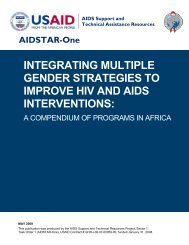Guide for Community Assessments on Women's Health Care - ICRW
Guide for Community Assessments on Women's Health Care - ICRW
Guide for Community Assessments on Women's Health Care - ICRW
You also want an ePaper? Increase the reach of your titles
YUMPU automatically turns print PDFs into web optimized ePapers that Google loves.
<str<strong>on</strong>g>Community</str<strong>on</strong>g> <str<strong>on</strong>g>Assessments</str<strong>on</strong>g> Facilitate Greater Learning<br />
The community assessment methodology drew <strong>on</strong> the methods of participatory learning<br />
and acti<strong>on</strong> (PLA), an approach that builds <strong>on</strong> local knowledge and experience. <str<strong>on</strong>g>Community</str<strong>on</strong>g><br />
participants talk about their lives, c<strong>on</strong>cerns and priorities, and then identify, discuss and<br />
ultimately devise soluti<strong>on</strong>s <str<strong>on</strong>g>for</str<strong>on</strong>g> their own problems. The process helps both the community and<br />
the team facilitating the community assessment gain a deeper understanding of the issues.<br />
Getting the women to talk openly about their health c<strong>on</strong>cerns and experiences meant breaking<br />
through the taboos around HIV, sexually transmitted infecti<strong>on</strong>s (STIs), aborti<strong>on</strong>, female genital<br />
mutilati<strong>on</strong>, rape and sexual abuse. These are sensitive issues that women rarely talk about<br />
privately, much less publicly. The participatory learning tools were carefully chosen to help get<br />
these issues into the open. Body Mapping, <str<strong>on</strong>g>for</str<strong>on</strong>g> example, was used because of its capacity to<br />
encourage women to name the parts of their bodies, including sexual body parts. Once women<br />
started talking about the vagina, clitoris and other sexual body parts in explicit language, the<br />
ice was broken and they began to talk about health issues which affect the body, including STIs<br />
and violence. Getting the women to talk about these issues pers<strong>on</strong>ally took careful facilitati<strong>on</strong><br />
and the creati<strong>on</strong> of a com<str<strong>on</strong>g>for</str<strong>on</strong>g>table and safe envir<strong>on</strong>ment in which they could feel free to express<br />
themselves.<br />
Another key feature of the community assessment approach was collecting data from different<br />
stakeholders – HIV-positive women, n<strong>on</strong>-positive women, service providers and community<br />
leaders. After meeting separately to talk openly and clarify their own ideas, all peer groups came<br />
together <str<strong>on</strong>g>for</str<strong>on</strong>g> a joint meeting to share what they had discussed and work together to analyze and<br />
discuss how to solve the problems.<br />
In summary, the community assessment approach used by the Parliamentarians <str<strong>on</strong>g>for</str<strong>on</strong>g> Women’s<br />
<strong>Health</strong> project involved:<br />
●●<br />
Separate workshops with different stakeholder groups, including HIV-positive women,<br />
HIV-negative and untested women, service providers and community leaders.<br />
● ● A joint workshop with all stakeholder groups.<br />
● ● Use of different participatory methods and the expertise of skilled facilitators to get<br />
participants talking openly, raising issues and analyzing their own experiences.<br />
● ● Involvement of HIV-positive women as key planners and facilitators of the process, and<br />
the parliamentarians as co-facilitators and active listeners.<br />
The process helped the community to:<br />
●●<br />
●●<br />
●●<br />
●●<br />
●●<br />
●●<br />
Identify and prioritize the main health problems women face.<br />
Map the services available in the community to address these problems.<br />
Define the crucial gaps in services.<br />
Analyze women’s experience in using health services.<br />
Identify barriers to health services.<br />
Identify crucial problems that undermine women’s health as well as possible soluti<strong>on</strong>s.<br />
12 Chapter A: Introducti<strong>on</strong>

















